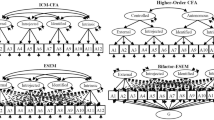Abstract
To gauge relations between perceived self-efficacy and behavior, researchers have employed a “microanalytic congruence” measure that assesses the percentage of individual tasks for which self-efficacy judgments and performance are congruent. Lee (1985) has proposed that chi-square analyses should be employed to assess the statistical significance of efficacy-behavior congruences. The present paper demonstrates that such analyses are inappropriate. Chi-square analyses assume that each of the observations being analyzed is independent of each of the other observations. This assumption is violated in self-efficacy data because each individual subject contributes more than one observation to the analysis. Alternative analyses of self-efficacy data are discussed.
Similar content being viewed by others
References
Bandura, A. (1977). Self-efficacy: Toward a unifying theory of behavioral change.Psychological Review, 84 199–215.
Bandura, A. (1980). Gauging the relationship between self-efficacy judgment and action.Cognitive Therapy and Research, 4 263–268.
Bandura, A., Adams, N. E., & Beyer, J. (1977). Cognitive processes mediating behavioral change.Journal of Personality and Social Psychology, 35 125–139.
Cervone, D. (1985). Randomization tests to determine significance levels for microanalytic congruences between self-efficacy and behavior.Cognitive Therapy and Research, 9 357–365.
DeGroot, M. (1986).Probability and statistics (2nd ed.). Reading, Massachusetts: Addison-Wesley.
Edgington, E. S. (1980).Randomization tests. New York: Marcel-Dekker.
Hays, W. L. (1963).Statistics for psychologists. New York: Holt, Rinehart & Winston.
Kirsch, I. (1980). “Microanalytic” analyses of efficacy expectations as predictors of performance.Cognitive Therapy and Research, 4 259–262.
Kirsch, I., & Wickless, C. V. (1983). Concordance rates between self-efficacy and approach behavior are redundant.Cognitive Therapy and Research, 7 179–188.
Lee, C. (1985). Efficacy expectations as predictors of performance: Meaningful measures of microanalytic match.Cognitive Therapy and Research 9 367–370.
Williams, S. L., Dooseman, G., & Kliefield, E. (1984). Comparative power of guided mastery and exposure treatments for intractable phobias.Journal of Consulting and Clinical Psychology, 52 505–518.
Author information
Authors and Affiliations
Additional information
Gratitude is expressed to Morris DeGroot for his statistical suggestions and to Ron Pavone for his comments on the manuscript.
Rights and permissions
About this article
Cite this article
Cervone, D. Chi-square analyses of self-efficacy data: A cautionary note. Cogn Ther Res 11, 709–714 (1987). https://doi.org/10.1007/BF01176007
Issue Date:
DOI: https://doi.org/10.1007/BF01176007




